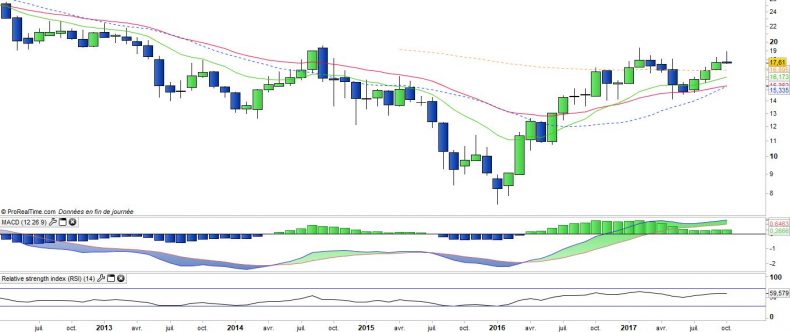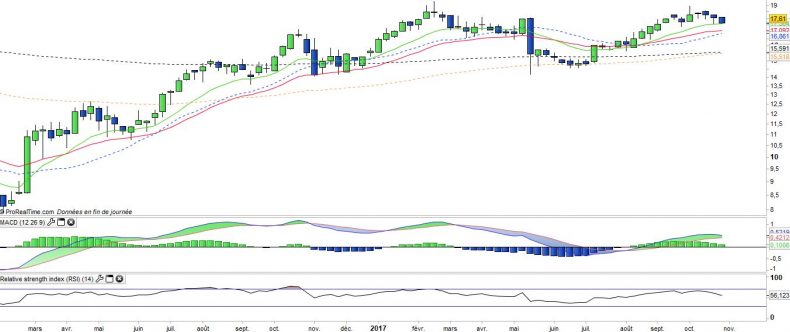Lyxor ETF Brazil Ibovespa - RIO - 31/10/2017
Short term strategy : Positive (90%) / Trend -
Long term strategy : Positive (100%) / Trend =
Characteristics of the ETF
The Lyxor RIO ETF (Brazil Index), created in 01/2007 and listed in Euro on Euronext, seeks to replicate the IBOVESPA index which is composed of the 58 main Brazilian stocks, selected according to the size of their market capitalization. This index covers 70% of the Brazilian market capitalization.
The costs of this ETF are 0.65% and the AUM approximately €313m. Replication is indirect (via Swap) and dividends are capitalized.
Alternative ETFs: BRZ ( Amundi in USD), iShares ( USD)
Index & components
The country's RIO (Lyxor) ETF is a very good proxy for the Brazilian economy. Financials make up 34% of the index, while energy accounts for only 12%, after the steep drop in Petrobras prices following the collapse in oil prices and corruption scandals. Brazil is the ninth world economy with a GDP of $ 1800bn (the equivalent of Italy).
After a period of very strong growth, the economy has been showing signs of slowing down since 2011 due to the stagnation of commodities prices, the slowdown in domestic consumption linked to household debt and lower investments. In 2016, the Brazilian economy plunged into recession (-3.5%) and fiscal difficulties increased. The popularity of President Dilma Rousseff collapsed, and she was targeted by impeachment proceedings, accused of manipulating the public accounts to facilitate her reelection in 2014.
Attempts to adjust and control the budget inflation failed and Brazil's sovereign debt rating was downgraded by two rating agencies as the country lost its investment grade status. However, with a population of more than 200 million, Brazil also has abundant natural resources and a relatively diversified economy. Brazil is the world's largest producer of coffee, sugar cane and oranges, one of the world's leading soybean producers, and the country attracts many global agribusiness and biofuel groups. Brazil is also a big industrial country.
The exploitation of its mineral wealth has made it the second largest exporter of iron ore and one of the largest producers of aluminum and coal. As a producer of oil, Brazil is considering self-sufficiency in short-term energy production (its reserves could make it one of the top five oil producers). The country is becoming increasingly important in the textile, aeronautics, pharmaceuticals, automotive, steel and chemical industries. Most major automobile manufacturers have established production units in the country. Brazil is expected to emerge from recession in 2017 and has strong medium-term growth potential, yet the country remains highly dependent on oil and commodities.
Latest developments
After a rise of nearly 73% in 2016, the rise in the Brazilian index continues in 2017 and has posted a performance of + 15.1% since the beginning of the year. After a good start to the year, Brazil has fallen back into the political crisis after Mr. Temer's corruption allegations, which for the moment have managed to maintain power despite the impeachment procedures and a popularity rate dropped to 3% which makes him the most unpopular president since the military dictatorship (1964-1985). It should be maintained until the next elections scheduled for autumn 2018.
After a historic recession, marked by a slump in GDP of - 3.7% in 2015 and - 3.5% in 2016, growth has returned positive in the first quarter (+ 1%), and second quarter (+ 0.3%) 2017 suggesting a modest increase of 0.7% in 2017. One of the main drivers of the upturn at the beginning of the year was the agricultural sector (responsible for 0.8 point of 1% growth) that uses advanced technologies, exports to China and Africa, creates jobs and develops cities in the interior of the country. In the second quarter, growth was mainly driven by services and household consumption.
Brazil's central bank has just reduced the pace of its monetary easing, but has signaled it is likely to return interest rates to record lows next month, in an attempt to support the recovery while keeping Inflation control, the reference rate was lowered from 75 bp to 7.50% after four consecutive declines of 100 bp each.
Monthly data
The monthly chart shows a fairly recent positive long-term trend, which started at the end of 2016 after 6 years of bear market. The candlestick of October because of its small size and its upper shadow reflects an hesitation that could indicate a pause on these levels after 3 months of bullish recovery. However, the upward character of the trend is absolutely not called into question, only its short-term development.
Weekly data
On the weekly chart, we can see that prices have entered a short-term correction phase for 3 weeks. However, a rebound could possibly took place this week on the EMA13 and confirm a positive reaction from buyers, and therefore plead for the end of the correction.
The validation of this scenario will be achieved by exceeding the 19 € zone.
ETF Objective
RIO (IBOVESPA) is a UCITS compliant ETF that aims to track the benchmark index Bovespa.
Characteristics
| Inception date | 24/01/2007 |
| Expense ratio | 0,65% |
| Benchmark | Indice Ibovespa |
| Ticker | RIO |
| ISIN | FR0010408799 |
| Currency | € |
| UCITS | Yes |
| EU-SD Status | Out of scope |
| Exchange | Euronext Paris |
| Assets Under Management | 317 M€ |
| Replication Method | Indirect (Swap) |
| Dividend | Capitalization |
| PEA (France) | No |
| SRD (France) | Yes |
| Currency risk | Yes |
| Number of Holdings | 59 |
| Risk | 4/5 |
Country Breakdown
| Brazil | 100% |
Sector Breakdown
| Financials | 34% |
| Consumer Staples | 14% |
| Materials | 14% |
| Energy | 12% |
| Consumer discretionary | 7% |
| Utilities | 6% |
| Industrials | 6% |
| Others | 8% |
Top Ten Holdings
| Itau Unibanco | 11% |
| Petrobras | 9% |
| Banco Bradesco | 8% |
| Vale | 8% |
| Ambev | 7% |
| BM&FBOVESPA | 4% |
| Banco do Brasil | 4% |
| Itausa investimentos | 3% |
| BRF | 3% |


